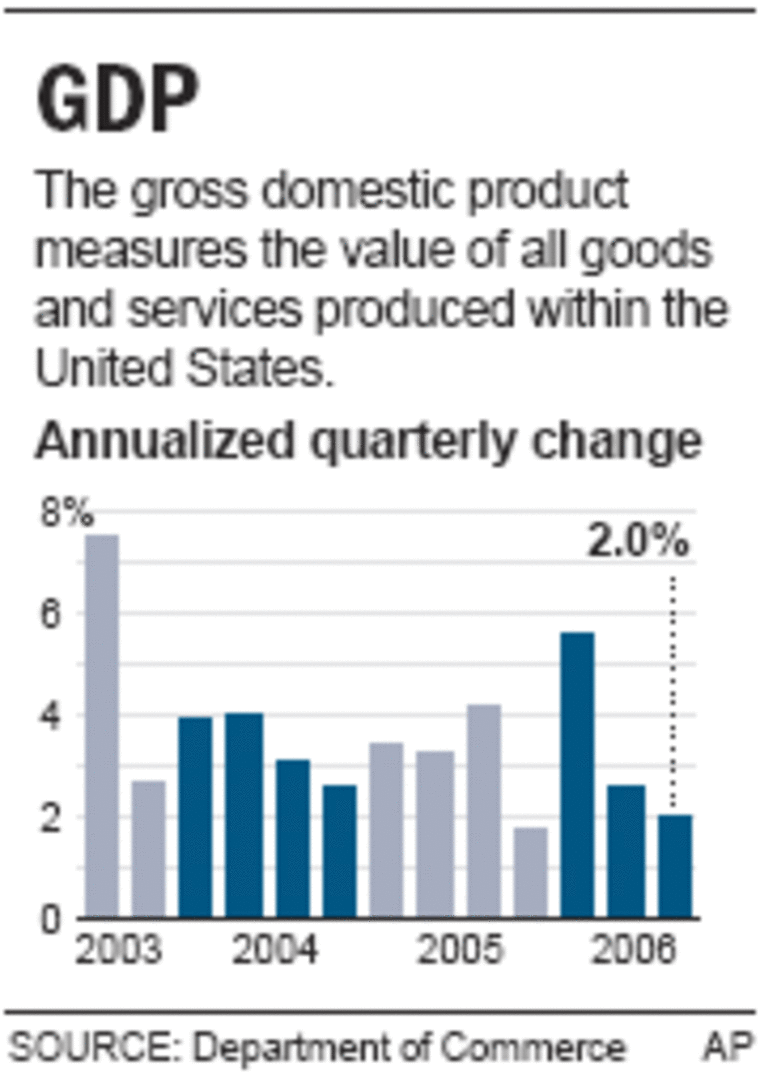The economy felt the strain of the housing bust and lost momentum in the late summer, with more sluggish performances expected in the months ahead.
Economic growth slowed to a 2 percent pace in the July-to-September quarter, the Commerce Department reported Thursday.
That was slightly worse than the 2.2 percent annual rate the government estimated a month ago, yet better than the anemic 1.6 percent rate initially calculated for those months.
Still, the message was loud and clear: The deepening housing slump is crimping growth.
“The housing market is profoundly weak,” said Ken Mayland, president of ClearView Economics. “The economic slowdown really took hold in the third quarter, and, I think, it is going to basically continue through the first half of next year.”
Investment in home building declined at a 18.7 percent rate — even more than previously estimated — and was the largest cut in 15 years. That shaved 1.2 percentage points off third-quarter growth, the most in nearly 25 years.

On Wall Street, stocks fell. The Dow Jones industrials lost 42.62 points to close at 12,421.25.
Even with expectations that economic activity will continue to be subpar, Federal Reserve Chairman Ben Bernanke and most analysts do not expect the troubled housing market will undermine the economy to the point it slides into a recession.
Economists say the gross domestic product in the October-to-December quarter could come in at a pace of 1.7 percent to 2.5 percent, or slightly higher. Growth estimates for the first quarter of 2007 are in the same range.
GDP measures the value of all goods and services produced in the United States. It is the best barometer of the country’s economic health.
The housing slump will bite into overall growth, but not too badly, some economists hope. Housing will continue to “contract during 2007 but at nowhere near the hemorrhage of the third quarter,” said T.J. Marta, fixed-income strategist for RBC Capital Markets.
In other economic news, the Labor Department reported that the number of newly laid-off workers signing up for unemployment benefits rose by 9,000 to 315,000 last week. The uptick did not alter economists’ views that the jobs climate is decent.
The Conference Board reported that a gauge of future economic activity advanced 0.1 percent in November, suggesting the economy is not in danger of stalling.
The economy has lost momentum all year long. The crumbling housing market, the toll of the Federal Reserve’s two-year credit tightening campaign and once-surging energy prices have affected economic activity.
In the first three months of this year, the economy grew at a hot 5.6 percent pace, the strongest spurt in 2 1/2 years. Growth slowed to a 2.6 percent pace from April through June as energy prices and the impact of higher borrowing costs turned consumers and businesses cautious.
Republicans and Democrats have differing views on the extent to which people in the U.S. have benefited from the economic expansion over the past five years. A priority for the Democrat-controlled Congress, which convenes in January, will be raising the federal minimum wage, which has not gone up in nearly 10 years.
In the third quarter, consumers boosted their spending at a 2.8 percent pace.
Business spending on equipment and software rose at an annual rate of 7.7 percent, an improvement from the second quarter when such spending was trimmed. Businesses’ spending on new plants and buildings also was up sharply in the third quarter.
Companies’ profits gained ground in the third quarter. One measure showed after-tax profits rising by 4.2 percent, compared with a meager 0.3 percent increase logged in the prior quarter.
As the economy has slowed, so, too, has inflation.
An inflation gauge tied to the GDP report showed that core prices — excluding food and energy — rose at a rate of 2.2 percent in the third quarter, down from a 2.7 percent pace in the second quarter. Energy prices, which had soared in the summer, have calmed down.
The Fed predicts core inflation — while still too high for its tastes — will fall in the months ahead as economic growth remains subdued.
Against that backdrop, the central bank has felt comfortable holding interest rates steady, which it has done since August. The Fed’s goal is to slow the economy enough to thwart inflation, but not so much as to cripple economic activity.